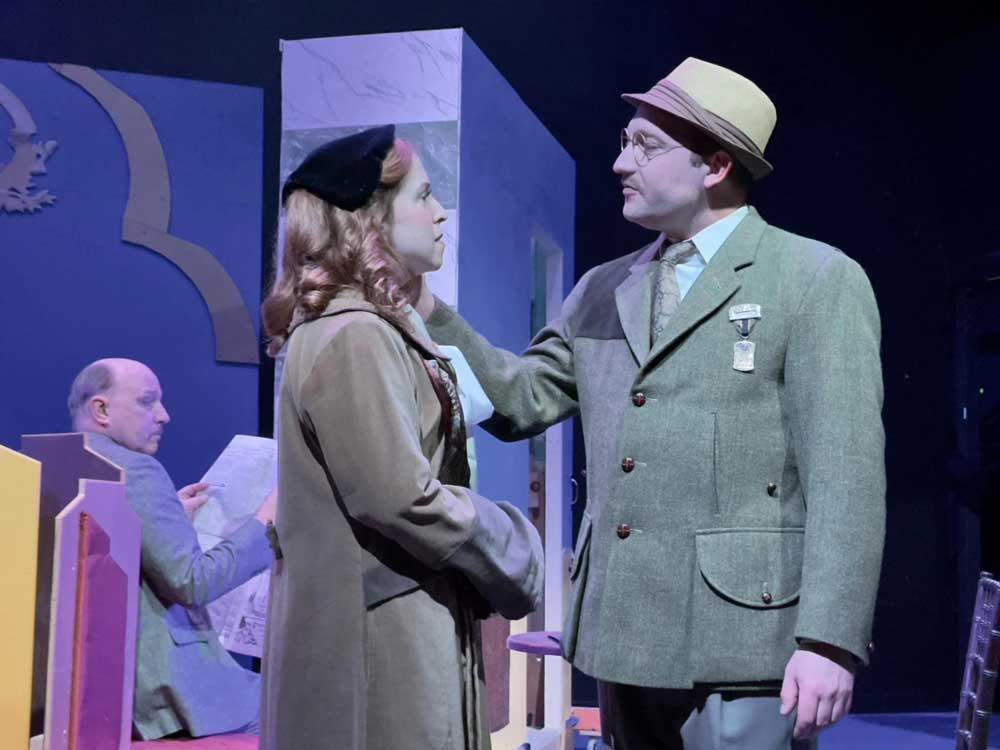THEATER REVIEW: All aboard — Collaborative Theatre Project stages Agatha Christie classic ‘Murder on the Orient Express’ (copy)
Published 3:47 pm Monday, January 29, 2024

- Russell Lloyd, left background, as Inspector Poirot, listens in on a conversation between two fellow travelers on the train in Collaborative Theatre Project's production of Agatha Christie classic "Murder on the Orient Express."
The Orient Express, the luxury train that ran across Europe for almost 100 years beginning in 1883, is being resurrected for the Paris 2024 Olympics.
Trending
Its original route stretched all the way from Paris to Istanbul. With its art deco interiors and luxurious décor, refined wood paneling and decked out sleeping cars, it carried everyone from the crown heads of Europe to Lawrence of Arabia to Mata Hari. The insanely rich waited in elaborately designed train stations to board this marvel of the industrial age.
As porters dashed in between stacked hat boxes and trunks, restless men in waistcoats escorted women adorned in furs and bonnets with pedigree dogs in tow. One such passenger was none other than author Agatha Christie, who was inspired to write the most famous of all her murder mysteries, based on the kidnapping and subsequent murder of the Lindbergh baby.
It became “Murder on the Orient Express.”
Trending
Along with the train, this classic has once again been resurrected at the Collaborative Theatre Project in Medford, and like a trip to Europe, this is one adventure you should probably experience once in your life.
There are numerous film versions and play adaptations, because directors love to reinvent it and actors love to play its imperious, sometimes charming, mustachioed detective Hercule Poirot. All the “Orient” stories arrive at the same surprising conclusion, however, thanks to the laser-focused observations of the inimitable Inspector.
Over the decades, Poirot has been played from stoic, humorless, undeterred and elusive, to sarcastic and congenial. He has also been revealed as a man of “sensitivity and refinement,” as described in Ken Ludwig’s adaptation and the source for the current CTP presentation.
Actor Russell Lloyd certainly has a long line of Poirot shoes to fill, and he has stepped into the character with a self-assured determination and a persuasive will. He does not play Poirot with the same dogged attention to detail or reluctance to arrive at conclusions too hastily as actor Louis Lotorto did in last season’s Oregon Cabaret Theatre production, “Murder of Roger Ackroyd.”
Lloyd’s Poirot is more like Alfred Molina’s, easy-going yet observing. But that’s what makes Poirot such an interesting study — the fact that he is open to interpretation.
Lloyd is also joined by a cadré of fine actors, most of whom are part of CTP’s now recognizable, faithful troupe of talented, versatile players. For this show there are 10 of them, each playing a collection of characters who Inspector Poirot must interrogate to find a murderer.
The story begins when Poirot, on his way back to Paris from having completed a case in London, runs into his friend Monsieur Bouc, director of the Orient Express. Poirot has planned to return by plane when Bouc invites him to take advantage of all the rail excursion has to offer and Poirot acquiesces.
As the story pulls out of the station, it takes several surprising curves, including the murder of a notorious American gangster-racketeer, who has been dealing in the acquisition of stolen antiquities; an American woman, Mary Debenham (Alissa Barry) who is shot, and the train itself, which becomes stalled in a snow drift.
During the ensuing days, a parade of intriguing, seemingly unrelated characters aboard the train (with their own secret love affairs, apparent bitterness and motives), come under the scrutiny of Poirot and fellow passengers.
Why was the murdered gangster, Ratchett, (played with a chilling arrogance by Elliott Anderson) stabbed so many times? Why was he wearing a pocket watch in his pajamas? Why did the tipsy, histrionic, American actress (flamboyantly played by Kelley Ryan Vincent) in the adjoining cabin, insist a man was hiding in her room the night Ratchett was killed? Which porter lost a coat button on her stateroom floor? Why do all the suspects move about the train as if they have an uneasy familiarity with one another?
Director Michael Jenkinson keeps you guessing. In the program notes, Jenkinson calls Ken Ludwig’s adaptation a “fast-paced romp.” Although there is an interjection of humor, this viewer is glad it didn’t really present itself as a romp.
Other standouts are Lyndsay Nashington as the regal Countess Andrenyi; Elliot Anderson as Arbuthnot (who has mastered a most difficult Scottish brogue); Jeff McCamish as Bouc; Priscilla Quinby as Princess Dragomiroff; Suzanne Selber as Greta Ohlsson; Cole Song (always a standout player) as Hector MacQueen, and Nick Walker as Michael/Head Waiter.
The sets are a great improvement on those of last season’s final two productions. Scenic designer Nathan Ynacay and his crew have created some clever sleeping cars that transform quickly into various train parts and literally set the stage for the turn of events. The art deco vibe is fully present as well as the artwork dotting the hallways.
As with other CTP performances, a little more attention to detail would have gone a long way to making this visually fulfilled. With a simple addition of curtains in the train car windows and steam emanating from the bottom of the cars, the suggestive facades would have really checked all the boxes.
Ryan Kelley’s sound and light, coupled with Charles Baldwin’s projection design, did capture the feel of the stalled train caught in an avalanche. Enhanced sound effects like the train whistle as the train left the station, the exciting recognizable chug of the massive engine, the imposing sound of train wheels screeching to halt, the release of steam, were for the most part, missing.
You never really get a sense that this train is going anywhere. Or why it has stopped. Even the sound of railway workers yelling back and forth, trying to clear the tracks, would have enhanced the audience experience.
Costume designer Susan Aversa, with a wonderful eye for period attire, has once again outfitted the cast in some wonderful, elegant 1920s suits and gowns impressively worn by Priscilla Quinby and Kelley Vincent.
“Murder on the Orient Express” has become synonymous with a bygone era. At times it seems a bit dated, but the intrigue, the mystery endures. And let’s face it, who doesn’t love a good mystery?
Collaborative Theatre Project, 555 Medford Center, Medford, has performances of “Murder on the Orient Express,” scheduled for 7:30 p.m. Thursdays through Saturdays, and 1:30 p.m. Sundays, through Feb. 18. If this play were a film it would be rated PG-13 for suggested violence and subject matter. Tickets are $40, $35 for seniors and students. Tickets and information are available at ctpmedford.org, on Facebook, or by calling the box office at 541-779-1055. Group rates are available.









